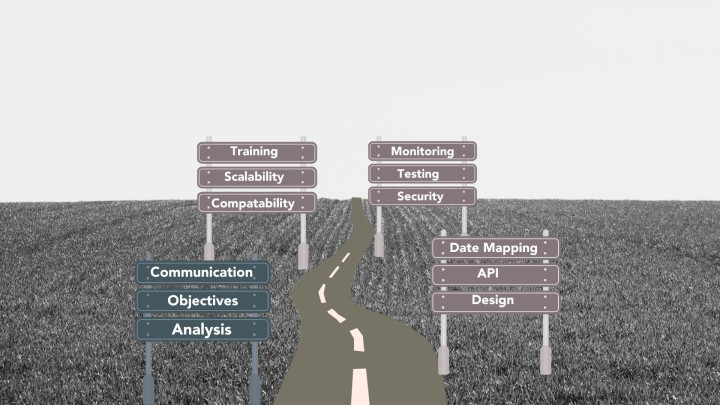Roadmap to integrate Bespoke software into your existing systems
Integrating a Bespoke system into your existing systems requires careful planning, consideration of existing infrastructure, and seamless coordination. Here is a roadmap guide to help you navigate this process.
1. Comprehensive System Analysis:
Conduct a detailed analysis that includes assessing the intricacies of your existing systems. Consider functionalities, data structures, and workflow patterns. This foundational step provides crucial insights into integration points and ensures that the bespoke system aligns seamlessly with your business processes.
2.Define Integration Objectives:
Clearly articulate the objectives of the integration. Whether your goal is to enhance workflow efficiency, streamline processes, enhance data sharing or introduce new features, having well-defined objectives helps in guiding the development and integration process. Ensure that these objectives align with broader business goals.
3. Open Communication Channels:
Foster a collaborative environment between your Bespoke software development team and existing IT personnel. Regular and open communication helps in sharing insights, addressing concerns, and aligning both teams with the integration goals. This collaborative approach ensures that the integration is a shared effort.
4. Modular Design Approach:
Embracing a modular design ensures flexibility during integration. Break down the bespoke system into independent modules or components, making it easier to integrate them into existing systems. This step-by-step approach minimizes disruptions, making the transition smoother for users.
5. Utilize Application Programming Interfaces (APIs):
APIs act as bridges between different software components. Select or design APIs that facilitate seamless communication between the bespoke system and existing systems. Ensure that the APIs support the data flow and functionalities required for effective integration.

6. Data Mapping and Migration:
Prioritize a comprehensive understanding of data structures within your organization. Create a robust plan for data mapping and migration, ensuring that data is transferred accurately and maintains consistency. Successful data migration is critical for a successful integration without data discrepancies.
7. Compatibility with Legacy Systems:
If your business relies on legacy systems, ensure that the bespoke system is designed with compatibility in mind. Consider solutions that allow for smooth interaction with older technologies, gradually integrating new features without compromising the functionality of existing systems.
8. Scalability for Future Integration:
Design the bespoke system with scalability as a core principle. Anticipate future technological advancements and plan for easy integration of new features and technologies. A scalable design ensures that your bespoke system remains adaptable, preventing obsolescence in the face of evolving business needs.
9. User Training and Onboarding:
Develop a comprehensive training program for existing users. It should cover the bespoke system's interface, functionalities, and benefits. A well-executed training program minimizes resistance to change, empowers users to leverage the new system effectively, and ensures a smooth transition.
10. Security and Compliance Considerations:
Prioritize security and compliance throughout the development and integration phases. Ensure that the bespoke system adheres to industry standards and regulatory requirements. Implement robust security measures to protect sensitive data, instilling confidence in users and stakeholders.
11. Pilot Testing:
Before a full-scale rollout, conduct pilot testing with a smaller group of users. This phase allows you to identify potential issues, gather feedback, and make necessary adjustments before a broader implementation. Pilot testing minimizes the risk of widespread disruptions.
12. Continuous Monitoring and Optimization:
Post-integration, implement continuous monitoring mechanisms. Regularly gather feedback from users and IT personnel to identify any emerging issues or areas for improvement. Ongoing monitoring ensures that the bespoke system remains aligned with evolving business needs, and optimization efforts can be undertaken as required.
By carefully navigating through these steps, you create a roadmap for the successful integration of bespoke software into your existing systems, promoting synergy and enhancing the overall efficiency of your business operations.

Admin Overload: The Silent Business Killer
The cost of manual, repetitive admin tasks In countless small and medium-s...
3 min read

eCommerce Trends 2025
The e-commerce landscape has been evolving at a rapid pace over the past fe...
5 min read

Shopify alternatives A comprehensive guide 2025
In the realm of e-commerce, Shopify has been a dominant player for years, r...
6 min read


